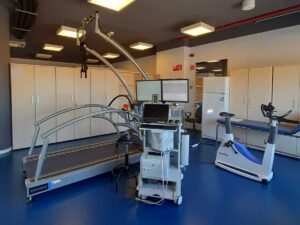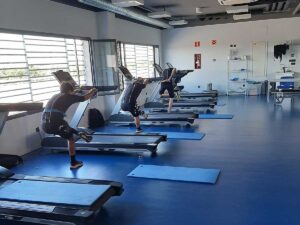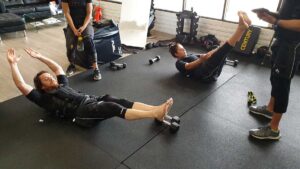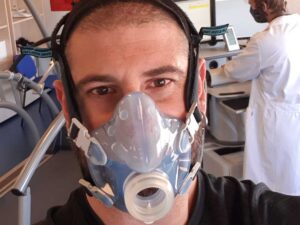Whole body electrostimulation (WB-EMS) is a novel technology that helps us save training time by producing greater adherence to training and is highly customizable. Therefore, WB-EMS could be a very effective alternative for those who have little time to train and low adherence to training [2]. Recent studies have confirmed that WB-EMS has a comparable effect on hypertrophy, muscle strength, and fat loss as high intensity resistance training. Interestingly, WB-EMS-induced body fat reductions regularly increase the hypertrophic effect of this technology.
Recent studies have confirmed that WB-EMS has a comparable effect on hypertrophy, muscle strength, and fat loss as high intensity resistance training. Interestingly, WB-EMS-induced reductions in body fat regularly increase the hypertrophic effect [3].
Therefore, the objective of this study was to evaluate the effects of WB-EMS on body composition during energy restriction, increasing physical activity in daily life and protein intake.
Ninety overweight women between the ages of 25 and 50 participated in this study. The 90 women were randomly divided into three groups. Control group (n = 30) which subjects had a negative energy balance due to an energy restriction with a compensatory protein intake. PA group (n = 30) In this group, the subjects also had a negative energy balance due to energy restriction and increased habitual physical activity in daily life with a higher protein intake. Finally, the group with full body electrostimulation (WB-EMS) was applied a negative energy balance due to energy restriction, increasing daily physical activity and protein intake, adding the plus of WB-EMS. The intervention was applied for 16 weeks in all groups.
All groups had a caloric deficit of -500 kcal / day with a protein intake of 1.2 g / kg in the control group and 1.7 g / kg in the PA group and the WB-EMS group.
Regarding the activity of the PA group, they executed a daily activity of 250 kcal / day, executing more daily steps at their usual walking speed. In a group with WB-EMS, in addition to applying the same treatment as the PA group, they carried out a 1.5 x 20 min / week training (every Tuesday and Friday, alternating one week yes and another no). For this, a full body electrostimulation device with wave parameters was used; rectangular, biphasic and offset. With a frequency of 85 Hz and a pulse width of 350 μs. The electrical impulse time was 6 s of work and 4 s of rest. In training, they performed 2 sets of 6-8 repetitions during the electrical impulse phase, executing low-range joint exercises (squats, trunk flexions, and chest openings). The duration of the first session was 12 min and each session increased by 2 min until reaching the fifth session, which took place 20 min and in the other sessions, the 20 min session was maintained. To adjust the intensity of the electrostimulation, the borg scale was applied over 10, with 5 (strong) and 7 (very strong). The coaches asked every 2-3 min to adjust the intensity so that the accommodation phase did not occur.
At the end of the intervention it was observed that the lean mass was reduced in the control group and in the PA group but it was increased in the WB-EMS group. As for fat mass, it decreased significantly in all groups.

Conclusion
The combination of WB-EMS and a high protein intake with a moderate energy deficit is an effective method to significantly improve body composition in overweight premenopausal women after a moderate energy deficit.
Informative note
This study does not specify whether study participants underwent prior adaptation to WB-EMS. Therefore, from Wiemspro we advise that before applying a WB-EMS training protocol, an adaptation period must be passed with a frequency below 50 Hz without reaching electrostimulation intensities that can cause high exhaustion for at least 6 -8 sessions.
Bibliography
- Willert, Sebastian; Weissenfels, Anja; Kohl, Matthias; von Stengel, Simon; Fröhlich, Michael; Kleinöder, Heinz; Schöne, Daniel; Teschler, Marc; Kemmler, Wolfgang. (2019). Effects of whole-body electromyostimulation on the energy-restriction-induced reduction of muscle mass during intended weight loss. Frontiers in Physiology (Q1), 10, 1-11.
- Kemmler, W., Weissenfels, A., Willert, S., Shojaa, M., Von Stengel, S., Filipovic, A., et al. (2018). Efficacy and safety of low frequency whole-body electromyostimulation (wb-ems) to improve health-related outcomes in non- athletic adults. A systematic review. Front. Physiol. 9:573. doi: 10.3389/ fphys.2018.00573.
- Kemmler, W., Teschler, M., Weissenfels, A., Bebenek, M., Frohlich, M., Kohl, M., et al. (2016). Effects of whole-body electromyostimulation versus high-intensity resistance exercise on body composition and strength: a randomized controlled study. Evid. Based Complement. Alternat. Med. 2016:9236809. doi: 10.1155/ 2016/9236809.







